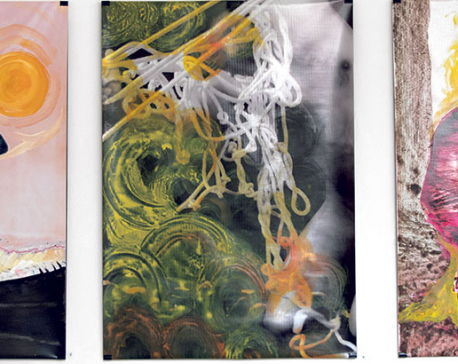
OR
expression

Here is a challenge. How many top women athletes of Nepal can you name immediately?
After the 2011 retirement of Guo Jingjing, the ever-graceful Chinese diver, I have been cheering for Katie Ledecty, the new American pool sensation. After winning four Gold medals in the 2016 Summer Olympics in Rio, Ledecty is now setting the Swimming World Championship in Hungary on fire. But even as she has been breaking records, Ledecty has been unable to take the attention of her countrymen away from Michael Phelps.
Phelps, the most decorated Olympian of all time, is not even taking part in the Budapest event. While most Americans have ignored Ledecty’s amazing feats, they happily tuned into Discovery Channel to watch Phelps race against a great white shark. It turned out that the shark was not even real but only a computer-generated image. Yet in TV ratings, the virtual race in South Africa beat the real race in Hungary, hands down. Don’t blame the Americans. Blame the universal bias for male athletes.
Here is a challenge. How many top women athletes of Nepal can you name immediately? Let me give it a try. Sangina Baidya. Gaurika Singh. Umm, I struggle for a third name. Now let me try to name a few male athletes. Paras Khadka. Sharad Vesawkar. Bimal Gharti Magar. Biraj Maharjan. Ganesh Thapa. Baikuntha Manandhar. Deepak Bista. I could perhaps give you at least 10 more names instantly. But why do I, a supposed fan of all sports, have this bias for male players?
I found myself asking this at the end of the scintillating women’s cricket world cup final between England and India last Sunday. In fact, it was the first time I had watched a women’s cricket match. Frankly, at first, even though it was a world cup final, the players seemed slow, their shots weak, the bowlers rather lame, and the fielders sluggish. But as the match wore on I got used to the pace and found myself more and more intrigued; in the end, it turned out to be a humdinger, with England barely squeaking to victory.
Given this wonderful experience, am I likely to watch women’s cricket matches in the future? Unlikely. First, since most viewers, including women, prefer to watch men play, sports channels skip most women’s matches—and not just in cricket. The women of Chelsea and Manchester City football clubs duke it out every season, just like their male counterparts, yet most of us will not even hear of these matches. They are not broadcast in Nepal. Even if they were, nobody would watch them.
But they certainly flocked to watch Aamir Khan-starrer Dangal, which broke all box office records in India (and even in China). It is a story about how a father nurtured his two daughters to be world-class wrestlers, the two women in the process breaking every imaginable gender stereotype. Yet real-life wrestlers Geeta Phogat and Babita Kumari that this film is based on were largely unknown to most Indians before the 2016 release of Dangal. India, incidentally, is also the country that worships Sachin Tendulkar as a demi-god.
Nepal has in recent times made great strides in gender equality. Our women have risen to become the country’s president, speaker, and chief justice. They are these days also better represented in almost all sectors. Yet, in sports, the field is as uneven as ever. Most of the money for sports development (as well as the big bucks from private sponsors) goes into men’s football and cricket. Women athletes have to make do with tiny leftovers. But this is not a big issue because in Nepal, as is the case in the rest of the world, sports are seen as exclusive male preserves.
It is said sports are unifiers, bridges between different cultures and societies, hallowed arenas that uphold the highest human virtues. But modern-day sports are anything but unifying, virtuous endeavours. They are openly sexist, with a clear male bias. They are unequal, as the countries and the clubs that can spend the most invariable get the best results. Nor are they fair, with athletes coming up all kinds of innovative ways to hide their use of performance-enhancing drugs.
I was thinking of all these things as I was watching the women’s world cup final this Sunday. My mind also kept going back to the first cricket world cup final that I watched live on TV: the 1996 men’s world cup final between Australia and Sri Lanka. I had skipped school to watch the match. In all these years I have not forgotten Arvinda de Silva’s majestic and match-winning 107 not out.
Yes, even while watching women’s world cup final, I could not help compare the players to their male counterparts; it was almost as if I considered male cricketers the standard with which to compare cricketing women.
I may take a fancy to the likes of Guo and Ledecty, but my biggest sporting icon is, and will always be, the incomparable Roger Federer. I wouldn’t say Steffi Graf, would I?
The writer is the op-ed editor at Republica. He can be contacted at biswas.baral@gmail.com
You May Like This

Rains, hail come both as boon and bane for Sarlahi farmers
SARLAHI, Feb 10: The farmers who had endured drought for six months – from July to January - were delighted with... Read More...

‘Male Nude’ illustrates feminine sides of men
The ‘Male Nude’ art exhibition kicked off on the premises of MCube Gallery, Lalitpur on Friday. The exhibition features works... Read More...

Business, trade union leaders hail passage of new labor laws
KATHMANDU, August 18: Business and trade union leaders have termed the recent passage of Labor Act and Social Security Act as... Read More...







Just In
- NRB to provide collateral-free loans to foreign employment seekers
- NEB to publish Grade 12 results next week
- Body handover begins; Relatives remain dissatisfied with insurance, compensation amount
- NC defers its plan to join Koshi govt
- NRB to review microfinance loan interest rate
- 134 dead in floods and landslides since onset of monsoon this year
- Mahakali Irrigation Project sees only 22 percent physical progress in 18 years
- Singapore now holds world's most powerful passport; Nepal stays at 98th











Leave A Comment